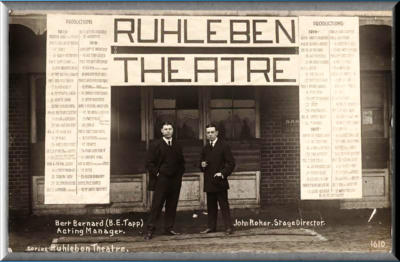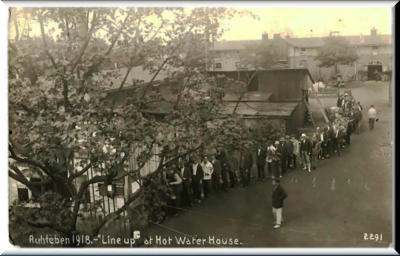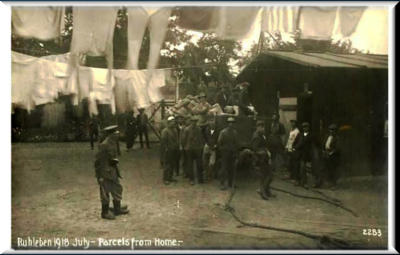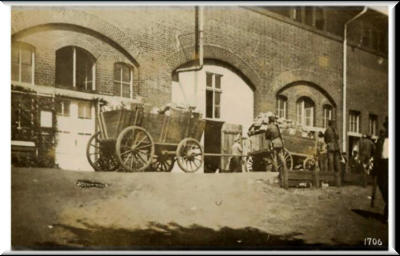


© Palatine Lodge - 1893 - 2023 - In se ipso totus teres -
There was also a hairdresser, watch repairer, laundry and a sandwich counter. Opposite, were a
book and music shop and a gentleman's outfitter, together with the theatre box office this is some years
after the first play and shows the remarkable number of productions that were staged. There was a
photograph orders office and a special orders office, where the prisoners could place an order for items
like tables and deck chairs which would then be brought to the Camp from Berlin. Elsewhere, there was a
boiler house which provided hot water for washing and boiling water for drinks, a cook-house, private
latrines, an exchange and mart service and even an internal mail service. There were also plenty of small
service enterprises like tailors, hairdressers or boot blacks who operated from their barracks or set up on
a daily basis. One enterprising inmate had a typewriter and he would type letters, for a fee.
Below the stairs of the first grandstand, was Fleet Street where the newspaper office,
engravers and printers were situated. A daily newspaper was printed and, occasionally, a camp magazine
was published, which ran to 60 or 70 pages and even featured advertisements. the Captain's committee
had set up eight sub committees to look after the organisation of these and other camp activities, which
were: Kitchens, Canteens, Watch and works (which included policing), Sanitation, Finance, Sports, Education and Entertainment, but probably the most important committee was the one
dealing with finance because amongst other things it dealt with the critical responsibility of distributing relief payments which, by 1915, were being received by more than half the camp's
inmates. From February 1915, each internee was entitled to withdraw a weekly amount of 4marks (which is about £70.00 in today’s terms) This was later increased to 5marks - about
£87.50. Incidentally, this allowance was only a loan from the British Government and each recipient had to
sign a weekly undertaking that he would repay the amount as soon as circumstances permitted. A bit like
today's student loan, although I don't think interest was charged.
In addition to British relief funds, by June 1915, tens of thousands of relief parcels were
coming into the camp which were the subject of cartoons in the magazine. British masons and United
Grand Lodge rallied to the aid of their brethren at Ruhleben.
The receiving, sorting and distribution of parcels was a massive enterprise which employed
a good number of prisoners. The goods vans, which arrived at a nearby railway siding, were opened by
the military, in the presence of the prisoners who then unloaded the parcels onto carts which they pulled
back to the camp. After the parcels had been sorted, a list of recipients was posted and the prisoners
queued at two windows, A to K or L to Z, to collect their packages. In May 1916 alone they received 40,000
parcels, nevertheless, it was apparent that not all the prisoners were receiving sufficient outside help so
the British Government sent a further 600 parcels a day for free distribution to the neediest.
So, that was how the Camp functioned on a daily basis and looked after the physical needs of the prisoners but probably the greatest challenge was not hunger or cold but
boredom. The men who were interned at Ruhleben Camp were a very mixed bunch. One of them was
called David Forman. He was the Captain of a ship that traded between Leith and various German ports
and, when war broke out, he was detained with his crew, when they were leaving Hamburg. He wrote a
letter to his brother describing his fellow prisoners, as follows:
‘There are many from Oxford and Cambridge - historians and all sorts of people; poets,
dentists, authors, housebreakers, painters, playwrights, actors, comedians, barristers, bankers, builders
and potters, cotton and wooden spinners, architects, mechanics, engineers, watch and clock makers,
doctors of chemistry and of languages, blacksmiths and silversmiths, leather workers - both fancy and
practical such as boot makers, turners in wood and brass, boat builders, mathematicians, vets,
footballers, cricketers and golfers, professional and amateur singers, cornet players and other musicians
of all kinds, ballet masters, commercial gentlemen of every degree and kind, ship masters, officers, cooks
and stewards, bakers and butlers, continental crooks and thieves, roulette and card toughs, newspaper
vendors and racecourse touts and a host of other useful and destructive people'.
So what do you do with such a disparate group of people who are crammed together 24 hours a day with no distractions? Well at Ruhleben they educated and
entertained them and organised a whole range of sporting activities. For a start, there was a considerable number of English academics and teachers, including 37 Cambridge graduates,
who had been working in German universities and schools. Almost as soon as they arrived at the camp,
they got together to found the Arts and Science Union to organise public lectures and also to promote
individual study. A couple of months later, the Camp school was started with a wide-ranging curriculum -
nearly 300 courses were on offer, starting at an elementary level and progressing to degree standard.
There were roughly 200 teachers and, eventually, about 1400 students whose efforts were supported by a
Camp lending library which, by the end of 1915, contained some five thousand books.
Language courses were very popular with a wider range on offer than you would find at
most universities including Hebrew, Yiddish and Ancient Greek. Eventually, some students sat for an
official degree and certificate examinations from the University of London, the London Chamber of
Commerce and the Royal Society of Arts, Manufactures and Commerce.





















